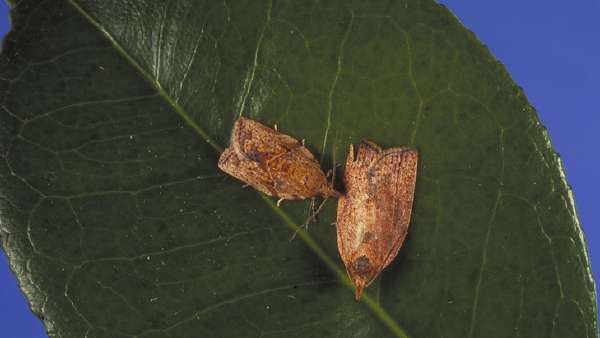For the past few weeks, the SF Bay Area news venues have erupted in talk about proposed aerial spraying of a pheromone product over large swaths of our urban communities in order to combat the spread of an agricultural pest, the light brown apple moth. I had never heard of this insect or known anything about previous sprayings in Santa Cruz and Monterey counties until after reading up on the subject. Now it’s time to educate my internet brethren about the facts surrounding this issue and resultant controversy.
The light brown apple moth, according to the Wikipedia article, is a leafroller moth originally from Australia. Besides their native Australian diet, the larvae feed on many fruit and ornamental plants. The damage to crops is apparently superficial, but can cause them to no longer be commercially viable. In New Zealand, the moth has been combatted for many years, but the most effective methods proved to be introducing natural predators, and using insect growth regulators while monitoring populations with sex pheromone traps. Moth populations actually increased during the years when organophosphate insecticides were utilized in response to the USDA’s zero tolerance quarantines, because both the insect and its predators were killed. Insecticide usage also resulted in chemical resistance in the moth. The Hawaii Department of Agriculture doesn’t consider the moth a significant pest, but actually regards its destruction of invasive gorse and blackberry beneficial.
The light brown apple moth was officially detected in California last year, and the CDFA declared an agricultural emergency, allowing them to bypass the typically required environmental impact report and public review. Experts have questioned their plan to spray synthetic pheromone pesticide products aerially, as well as the actual destructive impact these moths might have on California’s crops. Thousands of citizen activists are protesting to stop the spray of synthetic pheromones, along with other “inert” ingredients present in the proposed pesticide, that the CDFA has planned over San Francisco Bay Area urban areas. Beginning in August, the spraying would be conducted in 30- to 90-day intervals and be dropped by planes flying between 500 and 800 feet for at least the next few years. Last fall, aerial spraying conducted over Monterey and Santa Cruz counties resulted in hundreds of human health complaints ranging from difficulty breathing and asthma attacks to burning eyes and skin rashes, and there were also some reports of dead birds and sick pets. There have never been any studies of the long-term human toxicity of these synthetic pheromones in the microscopic plastic capsule format in which they are being sprayed, and there are additional ingredients which are highly toxic to aquatic species.
Many are also questioning the motivation behind the massive aerial spraying of urban areas, as opposed to the pheromone twist tie technique or more localized agricultural spraying. For example, to date there has been no extensive crop damage from the moth, which, considering its range, must have existed in the state for many years. The “emergency” seems to have been prompted by a USDA quarantine on exports from affected counties, and its declaration resulted in $75 million in funds made available from the federal agency to eradicate the moth, a goal that is probably unattainable according to experts, but $500,000 is being spent on PR to convince us otherwise. In addition, it has recently come to light that “the company that makes one of the pesticides state officials are considering spraying over the Bay Area to fight the light brown apple moth is owned by a wealthy California agribusinessman who has been a generous contributor to Gov. Arnold Schwarzenegger and other state officials.”
I encourage you to read all the sources you can find about this topic and come to your own conclusion. Either you decide, or they’ll decide for you.
